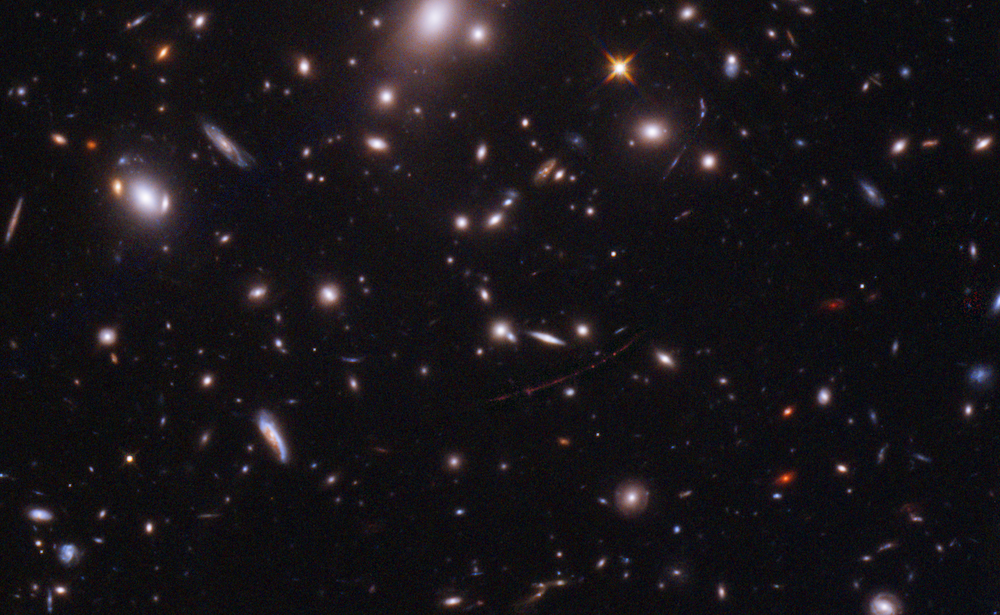The gravity of massive objects can magnify background objects, making them appear larger and brighter. Precise alignment between a background star and a foreground lens leads to extreme magnifications, allowing individual stars to be detected at great distances. This technique has recently revealed the most distant star yet observed, which existed when the universe was only 900 million years old.
Looking through a telescope takes us on a journey through time as well as space. It takes time for light to cross the vast expanse of space, so when we look at distant objects through our telescopes we see them as they appeared long ago. With the Hubble Space Telescope, astronomers have observed galaxies through 97% of the history of the universe, back to a mere 400 million years after the Big Bang. Our observations of galaxies during these early days of the universe, a time period known as Cosmic Dawn, have revealed that it is a remarkably different place than the modern universe. These galaxies are made up of billions of stars, and we see all of that starlight blended together. But, if we could pick apart the light from individual stars within such distant galaxies, we could learn more about how stars live and die in the early stages of the universe. Detecting stars outside the Milky Way is a technical challenge, as ever larger telescopes are required to observe more distant stars. However, natural telescopes called gravitational lenses can provide a boost to help identify a few very distant stars.
Einstein’s theory of General Relativity describes gravity as mass warping the fabric of space, much like a bowling ball warps a rubber sheet on which it is placed. As light travels through this distorted space, the light appears to bend, resulting in a lensing effect that magnifies and distorts the image of the background object.
When galaxies align with massive foreground lenses, they appear as elongated arcs, larger and brighter than they would typically appear. In certain cases, individual stars within such lensed galaxies can line up even more precisely with the foreground lens, resulting in extremely high magnifications.
This is exactly how we discovered the most distant star yet observed. Nestled within the longest known lensed arc of a galaxy, which we are seeing as it was within the first billion years of the universe, the star Earendel (Old English for “morning star”) is magnified to appear thousands of times brighter than usual thanks to a fortunate alignment with a massive cluster of galaxies.
The magnification, calculated from detailed modeling of the gravitational lens, allows us to calculate the maximum intrinsic size of the object. Earendel must be far smaller than any known galaxy or star cluster, limiting it to an individual star or binary star system.
Using the observed brightness of Earendel, along with our calculated magnification, we found the star’s intrinsic brightness to be around 1-10 million times the brightness of the Sun. For a star to be this bright, it has to be at least 50 times the mass of the Sun, making Earendel a particularly massive star.
Earendel, along with its host galaxy the Sunrise Arc, are far enough away that it took their light 12.9 billion years to reach our telescope. During this epic journey across space and time, the universe has been constantly expanding, stretching the light waves to longer, redder wavelengths. This phenomenon, called redshift, is responsible for the apparent red color of both star and arc. By measuring the amount of redshift, we can accurately determine the distance to both objects. This measurement informs us that we are seeing this star as it was a mere 900 million years after the Big Bang.
Everything we currently know about stars at this time of the universe has been inferred from looking at many stars blended together in galaxies. This discovery provides the first opportunity to study a single star or stellar system during Cosmic Dawn.
While the data from Hubble have revealed this fascinating object, the next step in our understanding of it will come from the James Webb Space Telescope. Webb will observe the star within its first year of observations and give us more information about the mass, temperature, and stellar type of Earendel, thanks to improved telescope technology. Additionally, Webb will be able to take a spectrum, splitting the light from the star up into its component wavelengths. This will help us to precisely determine the type of star, better constraining its mass and temperature. Finally, Webb will likely reveal more distant gravitationally lensed stars. Using this technique, it might directly observe the very first stars to form in the history of the universe.
Original Article:
Welch, B., Coe, D., Diego, J. M., Zitrin, A., Zackrisson, E., Dimauro, P., Jiménez-Teja, Y., Kelly, P., Mahler, G., Oguri, M., Timmes, F. X., Windhorst, R., Florian, M., de Mink, S. E., Avila, R. J., Anderson, J., Bradley, L., Sharon, K., Vikaeus, A., … Broadhurst, T. (2022). A highly magnified star at redshift 6.2. Nature, 603(7903), 815–818. https://doi.org/10.1038/s41586-022-04449-y
 Earth & Space
Earth & Space



